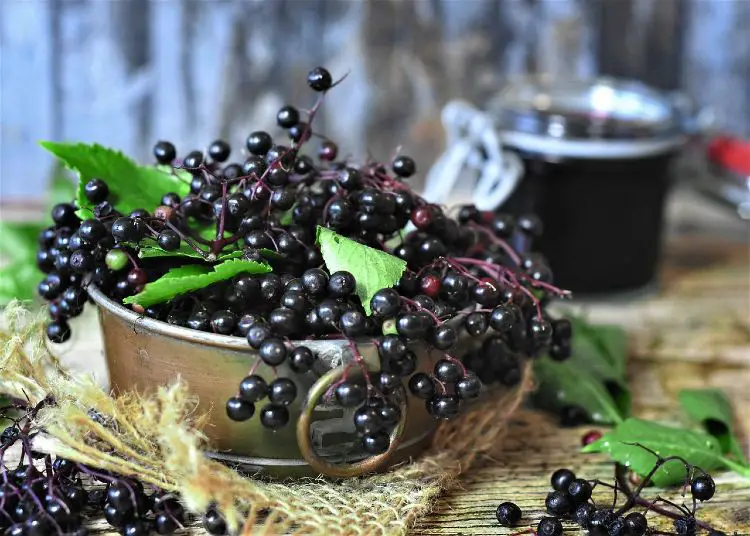What Does Elderberry Taste Like?
Quick Answer
Elderberries have a tart, slightly bitter, and earthy flavor when raw, with some people noting undertones similar to blackcurrant. They’re often cooked and sweetened to bring out a richer, fruitier profile that can include notes of plum and black cherry. Because of their tartness, they’re commonly used in jams, syrups, and wines.
What is Elderberry?
Elderberry refers to the berries that come from the Sambucus tree, a genus of flowering plants in the family Adoxaceae. The most common species used for its edible berries is Sambucus nigra, also known as European elderberry.
These berries are often used in traditional medicine and are commonly cooked and sweetened to make products like jams, syrups, and wines. It’s important to note that raw elderberries, as well as other parts of the plant, contain substances that can be toxic and should be cooked before consumption.
What Do Elderberries Taste Like?
When it comes to the natural, uncooked flavor of elderberries, the first thing you’ll notice is a distinct tartness, often accompanied by a slight bitterness.
The flavor is earthy, with undertones that are somewhat reminiscent of blackcurrant. Some people also detect a musky or wine-like nuance, adding complexity to its overall taste profile.
What is The Texture Of Elderberry?
The texture of elderberries can vary slightly depending on their ripeness and the specific variety, but generally, they are small, soft, and juicy when ripe. The skin is relatively thin, and the interior is fleshy and filled with multiple small seeds.
Because of the high water content, the berries are typically quite juicy, but they are not as fleshy or meaty as some other fruits like grapes or cherries. The seeds inside can add a slight crunch if consumed, although they are often removed when elderberries are processed into jams, syrups, or wines.
It’s worth noting that the texture can change substantially when elderberries are cooked or processed. In jams and syrups, for instance, the berries often become much softer and more uniform in texture, while in dried form, they can be quite chewy and raisin-like.
Differences Between Elderberry and Elderflower
Both elderberry and elderflower come from the same Sambucus plant, but they offer very different flavors, uses, and medicinal benefits.
Flavor Profile
- Elderberry: The berries provide a tart, slightly bitter, and earthy flavor. They are usually cooked and sweetened for consumption.
- Elderflower: The flowers offer a floral, sweet, and subtly fruity aroma and flavor, somewhat akin to lychee or pear.
Culinary Uses
- Elderberry: Commonly used in making jams, jellies, syrups, pies, and wines.
- Elderflower: Popular in making cordials, liqueurs (like St-Germain), teas, and even baked goods.
FAQs
Do Elderberries Taste Better When Cooked?
Cooking elderberries generally mellows out their tartness and bitterness, allowing for a richer, fruitier profile to emerge. The berries are often sweetened during cooking, making them more palatable for most people.
Can You Eat Elderberries Raw?
It’s not advisable to eat raw elderberries in large quantities, as they contain compounds that can be toxic. Cooking or fermenting them usually neutralizes these substances, making them safe to consume.
How Do Elderberries Compare To Other Berries Like Blueberries Or Blackberries?
Elderberries are generally more tart and less sweet than blueberries and blackberries. They have a unique earthy flavor that sets them apart from other berries.
What Dishes Or Recipes Commonly Use Elderberry?
Elderberries are often used in making jams, jellies, syrups, pies, and wines. They can also be dried and used like raisins in baked goods.
Do Different Species Of Elderberries Taste Different?
Yes, the flavor of elderberries can vary depending on the species. For example, the Sambucus nigra (European elderberry) is often described as less bitter than the Sambucus canadensis (American elderberry).
Are Elderberries Sour?
Elderberries are generally tart rather than sour, although unripe berries can be quite astringent and sour.
What Flavors Pair Well With Elderberry?
The rich, fruity profile of elderberry pairs well with flavors like cinnamon, nutmeg, and vanilla. It also complements other fruits like apple and pear.
How Can I Tell If My Elderberries Are Ripe?
Ripe elderberries are typically dark purple or black and will be softer to the touch. Unripe berries are often green or red and should be avoided as they are more astringent and potentially toxic.
What Does Elderberry Juice Taste Like?
Elderberry juice carries the tart, earthy essence of the raw berries but in a more concentrated form. The bitterness is usually less pronounced, thanks to the removal of the seeds and skin during processing. Often sweetened, the juice can develop a rich, wine-like quality with undertones of dark fruits like black cherries and plums. It is commonly diluted or mixed with other fruit juices to balance its robust flavor.
What Does Elderberry Syrup Taste Like?
Elderberry syrup is a cooked and typically sweetened form of elderberries. The cooking process softens the tartness and bitterness, making way for a smoother, more palatable experience. The syrup often has a deep, rich flavor that can be described as fruity and somewhat spicy, thanks to common additions like cinnamon or cloves. It is a popular choice for drizzling over pancakes or using as a natural sweetener in teas.
What Does Elderberry Jam Taste Like?
Elderberry jam presents the full gamut of the fruit’s complex flavor profile in a spreadable form. The tartness is mellowed significantly by the sugar added during the jam-making process, and the result is a rich, deep fruitiness with hints of black cherry and plum. The texture is generally smooth but can be chunky if the berries are not fully mashed. Elderberry jam is a delightful addition to toast, pastries, or even as a filling in baked goods.


